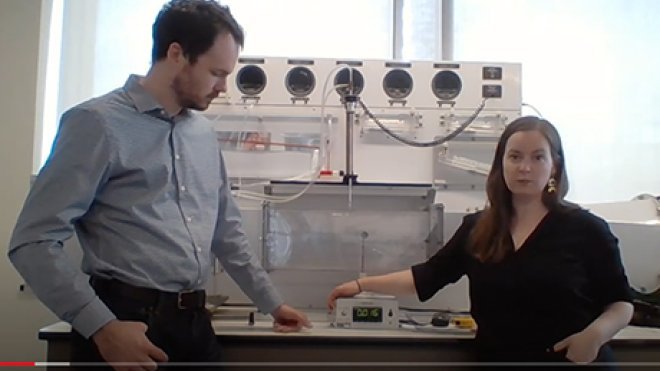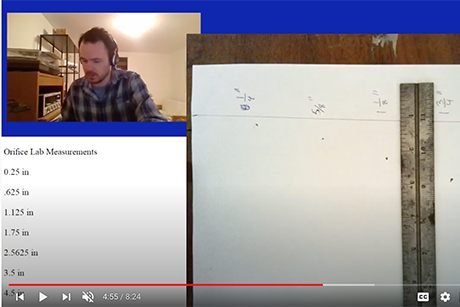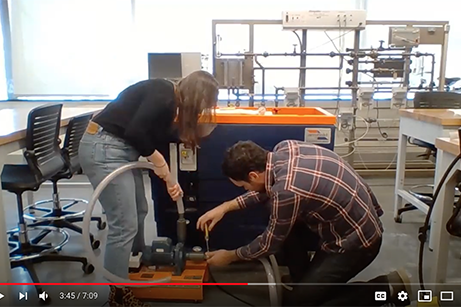How to Meet a Lab’s Hands-On Learning Goals? Engineering Professors are ’Working Hard to Make It Work’
RWU Engineering faculty put their ingenuity to work, from hands-on lab courses through video to practical lab approaches at home
This story is part of a series highlighting RWU's innovative, student-centered approaches to education, with classes online for the remainder of the semester

Social distancing measures can’t stop RWU engineering faculty from delivering experiential lab courses. Engineering professors are meeting learning goals remotely, bringing the laboratory experience directly to students via video.
Professors are using multiple methods to translate the experience of working with state-of-the-art laboratory equipment to remote education. For some labs, professors create in-depth videos of the lab process, allowing students to collect data from afar. Other labs are adapted to put students' homes to use as practical laboratories.
“All of my professors have been diligent in their efforts to make methods of delivery for the class material that works for them and works for us. Each professor is doing it a little differently, but we can still ask questions, professors still cold-call on people, and we can still hear people’s voices. Everyone is working hard to make it work,” said senior engineering major Olivia Ryan.
Engineering students appreciate their professors' commitment to providing a remote education, complete with lab work and data analysis.
“I am currently in a fluids lab class and my professors have been videoing themselves performing the lab. It's great because they explain it as they are going, and help you along the way as if you were doing it yourself. It’s still getting the job done in an efficient way," said junior engineering major Melanie Primpas. "We are still learning how to use the equipment and learning how the concepts we learn in class can be backed up by data and information. It’s still working, it’s just different.”
We recently talked with some engineering professors to hear about the creative ways they are making lab classes work from a distance.

Course: Mechanics of Materials and Lab
Faculty: Nicole Martino, Assistant Professor of Engineering
"All the faculty are putting student learning as a first priority. Both myself and Pam Judge [Assistant Professor of Engineering] are teaching sections of the lab, so when we learned we had to change to a virtual setting we made a plan.
Pam [Judge] and I went into the Mechanics and Materials Lab together. One of us acted as a student doing the lab experiment, and the other person filmed it. We went, step by step, through the instruction, showing how we measured each step. We share the videos with the students through Bridges. One week they watch a video of the experiment, and the next week they do the write up.
Honestly, it seems to be working out almost better than in lab, based on the students’ write-up portions. It was very efficient. It was a lot of work completing the experiments and recording them, but it is working out as well as I could have hoped for."
Course: Fluid Mechanics and Lab
Faculty: Maija Benitz, Assistant Professor of Engineering

"My husband, Adjunct Professor Gordon Stewart, and I each teach sections of the lab and are socially isolating together, which has allowed us the opportunity to go into the lab and film ourselves doing the lab without infecting anyone else. It certainly would be possible to film the lab by yourself, but it helps to have a lab assistant. So we feel very lucky.
We take zoomed-in video of the various measurements we are taking, whether it is a pressure measurement using various pumps, or if we are using the wind tunnel, we might zoom in and show velocity measurements, pressure measurements, or the rotation rate of the engine. Lots of numerical data shows up on camera, so the students not only watch the videos but understand the process of the data collection. By watching the videos, they are in some ways collecting the lab data on their own. They are getting all the data they would if they were physically in the lab, and can still do all of the analysis. In a lot of ways, we are still able to maintain the learning outcomes.
We’re setting up practical labs they can do in situ. Our original intention was to use the new SECCM labs building to do a practical lab, exploring how the water flows throughout that building, taking various flow rate measurement, and thinking about how the pressure varies depending what floor you’re on in the building. We’re transitioning that practical idea into the home. Students can make flow measurements at home and get ideas from their meter readings. They can gain a lot of practical learning using their own homes as a lab."
Course: Theory and Design for Mechanical Measurements
Faculty: Charles Thomas, Professor of Engineering
"In Engineering 350, the students apply principles I present in lecture to a half-semester long project. Usually, they would take apart an experimental apparatus that I’ve built, and then put it back together to become very familiar with it, but clearly that isn’t possible now. The substitute that I came up with was using a camera that I wear mounted next to my ear to film the apparatus. If I look at something, the camera looks at it automatically. I also have my hands free to point to various parts of the apparatus. I can’t meet the learning goal of them actually taking something apart and putting it back together, but I can meet the learning goal of them being able to identify the portions of the experiment and give them names, which is an important skill to have when you’re talking about building an experimental apparatus.
Everyone is concerned about connectivity for the students. I’ve elected to deliver my lessons live at the time the classes would have met, but of course there is the recording so students can access it at a different time. I also pre-record a quicker version of the lesson that students can access as well. We are trying to give them as many opportunities as possible to get access to the lessons."
“The professors are doing everything they can to accommodate us in the best ways that they can. Professor Thomas has gone above and beyond in every way. He’s always asking us if there is anything he can do better and keeping the communication as open as possible. The other professors have done the same,” said Primpas.
Related story:'A Lot of Silver Linings' for Engineering Majors Taking Senior Design Projects Online
Faculty, Students and Staff: Do you have a story of innovative distance learning at RWU? Email us at stories@rwu.edu

